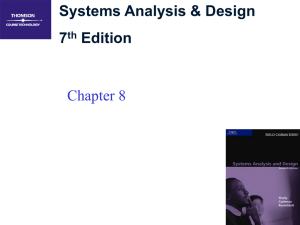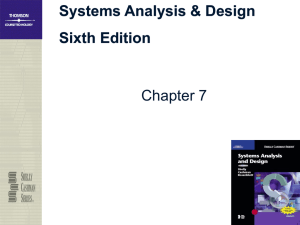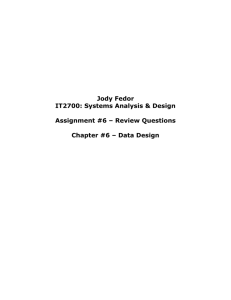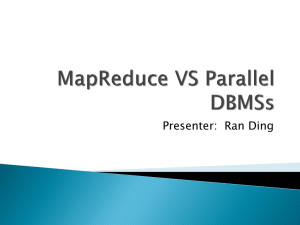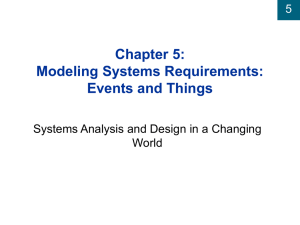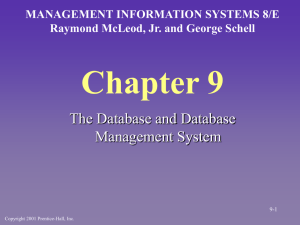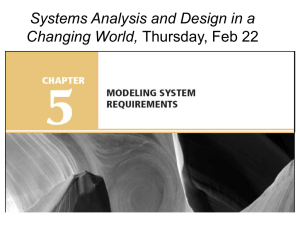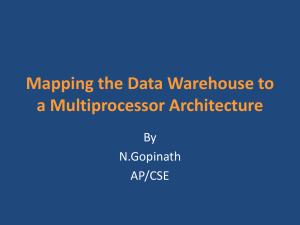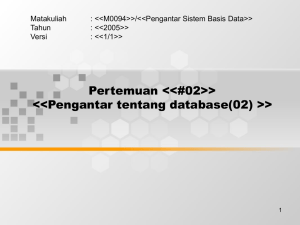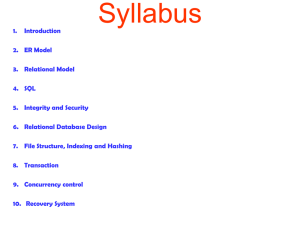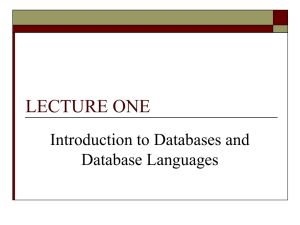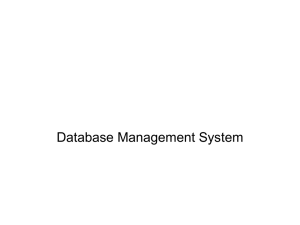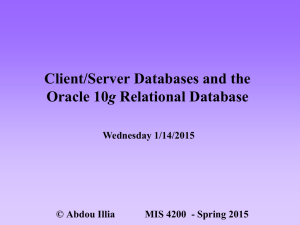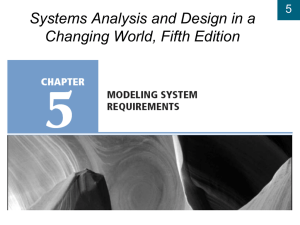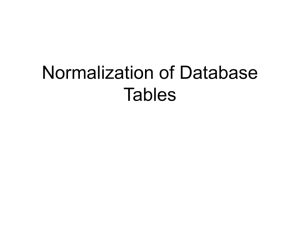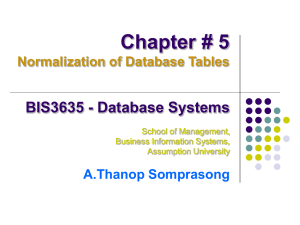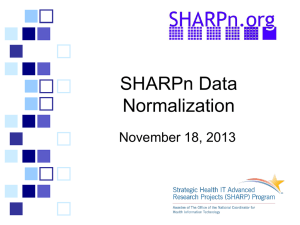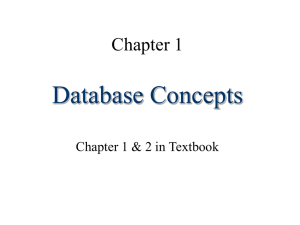Chapter 9
advertisement
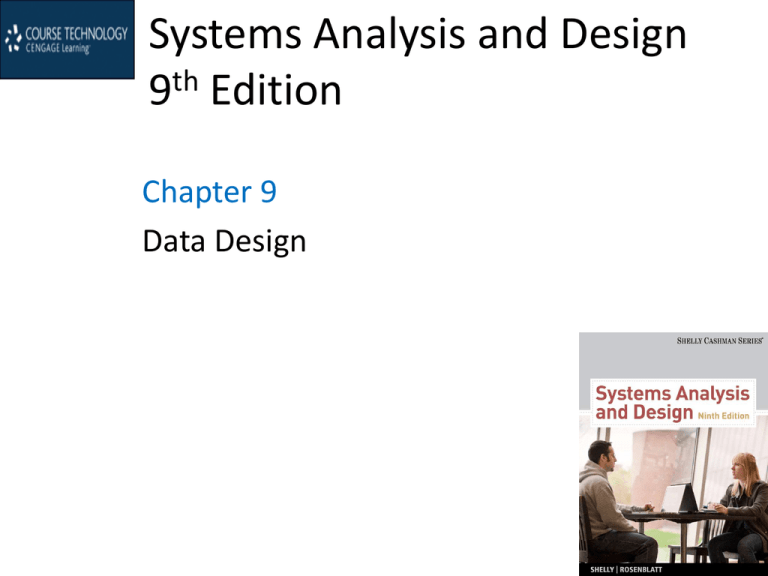
Systems Analysis and Design 9th Edition Chapter 9 Data Design Chapter Objectives • Explain file-oriented systems and how they differ from database management systems • Explain data design terminology, including entities, fields, common fields, records, files, tables, and key fields • Describe data relationships, draw an entity relationship diagram, define cardinality, and use cardinality notation • Explain the concept of normalization 2 Chapter Objectives • Explain the importance of codes and describe various coding schemes • Explain data warehousing and data mining • Differentiate between logical and physical storage and records • Explain data control measures 3 Introduction • Begins with a review of data design concepts and terminology, then discusses file-based systems and database systems, including Webbased databases • Concludes with a discussion of data storage and access, including strategic tools such as data warehousing and data mining, physical design issues, logical and physical records, data storage formats, and data controls 4 Data Design Concepts • Data Structures – Each file or table contains data about people, places, things or events that interact with the information system – File-oriented system – Database management system (DBMS) 5 Data Design Concepts • Overview of File Processing – File processing can be efficient and costeffective in certain situations – Potential problems • Data redundancy • Data integrity • Rigid data structure 6 Data Design Concepts • Overview of File Processing – Various types of files • • • • • • Master file Table file Transaction file Work file Security file History file 7 Data Design Concepts • The Evolution from File Systems to Database Systems – A database management system (DBMS) is a collection of tools, features, and interfaces that enables users to add, update, manage, access, and analyze the contents of a database – The main advantage of a DBMS is that it offers timely, interactive, and flexible data access 8 Data Design Concepts • The Evolution from File Systems to Database Systems – Some Advantages • • • • • Scalability Better support for client/server systems Economy of scale Flexible data sharing Enterprise-wide application – database administrator (DBA) • Stronger standards 9 DBMS Components • Interfaces for Users, Database Administrators, and Related Systems – Users • Query language • Query by example (QBE) • SQL (structured query language) – Database Administrators • A DBA is responsible for DBMS management and support 10 DBMS Components • Interfaces for Users, Database Administrators, and Related Systems – Related information systems • A DBMS can support several related information systems that provide input to, and require specific data from, the DBMS • No human intervention is required for two-way communication 11 DBMS Components • Data Manipulation Language – A data manipulation language (DML) controls database operations, including storing, retrieving, updating, and deleting data • Schema – The complete definition of a database, including descriptions of all fields, tables, and relationships, is called a schema – You also can define one or more subschemas 12 DBMS Components • Physical Data Repository – The data dictionary is transformed into a physical data repository, which also contains the schema and subschemas – The physical repository might be centralized, or distributed at several locations – ODBC – open database connectivity – JDBC – Java database connectivity 13 Web-Based Database Design • Characteristics of Web-Based Design 14 Web-Based Database Design • Internet Terminology – Web browser – Web page – HTML (Hypertext Markup Language) – Tags – Web server – Web site 15 Web-Based Database Design • Internet Terminology – Intranet – Extranet – Protocols – Web-centric – Clients – Servers 16 Web-Based Database Design • Connecting a Database to the Web – Database must be connected to the Internet or intranet – Middleware • Adobe ColdFusion • Data Security – Well-designed systems provide security at three levels: the database itself, the Web server, and the telecommunication links that connect the components of the system 17 Data Design Terminology • Definitions – – – – Entity Table or file Field Record • Tuple 18 Data Design Terminology • Key Fields – Primary key – Candidate key – Foreign key – Secondary key 19 Data Design Terminology • Referential Integrity – Validity checks can help avoid data input errors – In a relational database, referential integrity means that a foreign key value cannot be entered in one table unless it matches an existing primary key in another table – Orphan 20 Entity-Relationship Diagrams • Drawing an ERD – The first step is to list the entities that you identified during the fact-finding process and to consider the nature of the relationships that link them – A popular method is to represent entities as rectangles and relationships as diamond shapes 21 Entity-Relationship Diagrams • Types of Relationships – Three types of relationships can exist between entities – One-to-one relationship (1:1) – One-to-many relationship (1:M) – Many-to-many relationship (M:N) 22 Entity-Relationship Diagrams • Cardinality • Cardinality notation • Crow’s foot notation • Unified Modeling Language (UML) • Now that you understand database elements and their relationships, you can start designing tables 23 Normalization • Standard Notation Format – Designing tables is easier if you use a standard notation format to show a table’s structure, fields, and primary key – Example: NAME (FIELD 1, FIELD 2, FIELD 3) 24 Normalization • Repeating Groups and Unnormalized Design – Repeating groups • Often occur in manual documents prepared by users – Unnormalized – Enclose the repeating group of fields within a second set of parentheses 25 Normalization • First Normal Form – A table is in first normal form (1NF) if it does not contain a repeating group – To convert, you must expand the table’s primary key to include the primary key of the repeating group 26 Normalization • Second Normal Form – A table design is in second normal form (2NF) if it is in 1NF and if all fields that are not part of the primary key are functionally dependent on the entire primary key – A standard process exists for converting a table from 1NF to 2NF – The objective is to break the original table into two or more new tables and reassign the fields so that each nonkey field will depend on the entire primary key in its table 27 Normalization • Third Normal Form – 3NF design avoids redundancy and data integrity problems that still can exist in 2NF designs – A table design is in third normal form (3NF) if it is in 2NF and if no nonkey field is dependent on another nonkey field – To convert the table to 3NF, you must remove all fields from the 2NF table that depend on another nonkey field and place them in a new table that uses the nonkey field as a primary key 28 Normalization • A Normalization Example 29 Using Codes During Data Design • Overview of Codes – Because codes often are used to represent data, you encounter them constantly in your everyday life – They save storage space and costs, reduce data transmission time, and decrease data entry time – Can reduce data input errors 30 Using Codes During Data Design • Types of Codes 1. 2. 3. 4. 5. 6. 7. Sequence codes Block sequence codes Alphabetic codes Significant digit codes Derivation codes Cipher codes Action codes 31 Using Codes During Data Design • Developing a Code 1. 2. 3. 4. 5. Keep codes concise Allow for expansion Keep codes stable Make codes unique Use sortable codes 32 Using Codes During Data Design • Developing a Code 6. 7. 8. 9. Avoid confusing codes Make codes meaningful Use a code for a single purpose Keep codes consistent 33 Database Design: One Step At a Time 1. Create an initial ERD 2. Next, create an ERD 3. Review all the data elements 4. Review the 3NF designs for all tables 5. Double-check all data dictionary entries • After creating your final ERD and normalized table designs, you can transform them into a database 34 Database Models • A Real-World Business Example – Imagine a company that provides on-site service for electronic equipment, including parts and labor 35 Database Models • Working with a Relational Database – To understand the power and flexibility of a relational database, try the following exercise – Suppose you work in IT, and the sales team needs answers to three specific questions – The data might be stored physically in seven tables 36 Data Storage and Access • Data storage and access involve strategic business tools • Strategic tools for data storage and access – Data warehouse – dimensions – Data mart – Data Mining 37 Data Storage and Access • Logical and Physical Storage – Logical storage • Characters • Data element or data item • Logical record – Physical storage • Physical record or block • Buffer • Blocking factor 38 Data Storage and Access • Data Coding and Storage – – – – Binary digits Bit Byte EBCDIC, ASCII, and Binary – Unicode 39 Data Storage and Access • Data Coding and Storage – Storing dates • Y2K Issue • Most date formats now are based on the model established by the International Organization for Standardization (ISO) • Absolute date 40 Data Control • • • • • • • • User ID Password Permissions Encryption Backup Recovery procedures Audit log files Audit fields 41 Chapter Summary • Files and tables contain data about people, places, things, or events that affect the information system • DBMS designs are more powerful and flexible than traditional file-oriented systems 42 Chapter Summary • An entity-relationship (ERD) is a graphic representation of all system entities and the relationships among them • A code is a set of letters or numbers used to represent data in a system • The most common database models are relational and object-oriented 43 Chapter Summary • Logical storage is information seen through a user’s eyes, regardless of how or where that information actually is organized or stored • Physical storage is hardware-related and involves reading and writing blocks of binary data to physical media • File and database control measures include limiting access to the data, data encryption, backup/recovery procedures, audit-trail files, and internal audit fields 44 Chapter Summary • Chapter 9 complete 45
